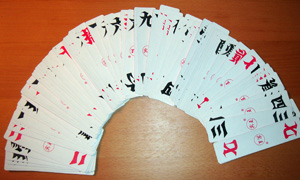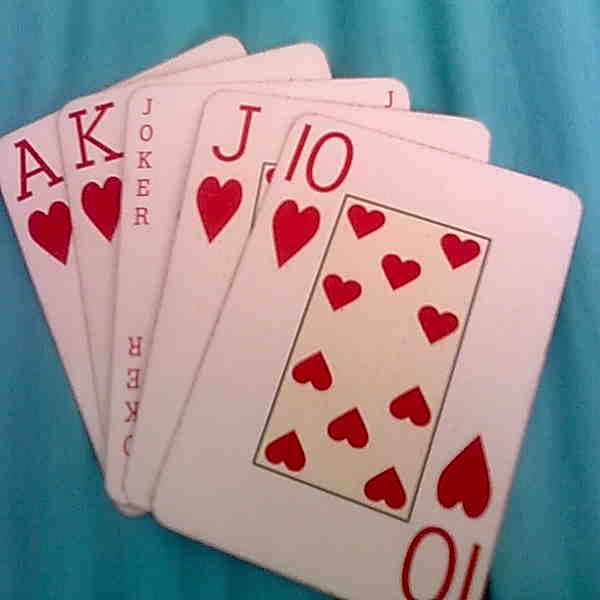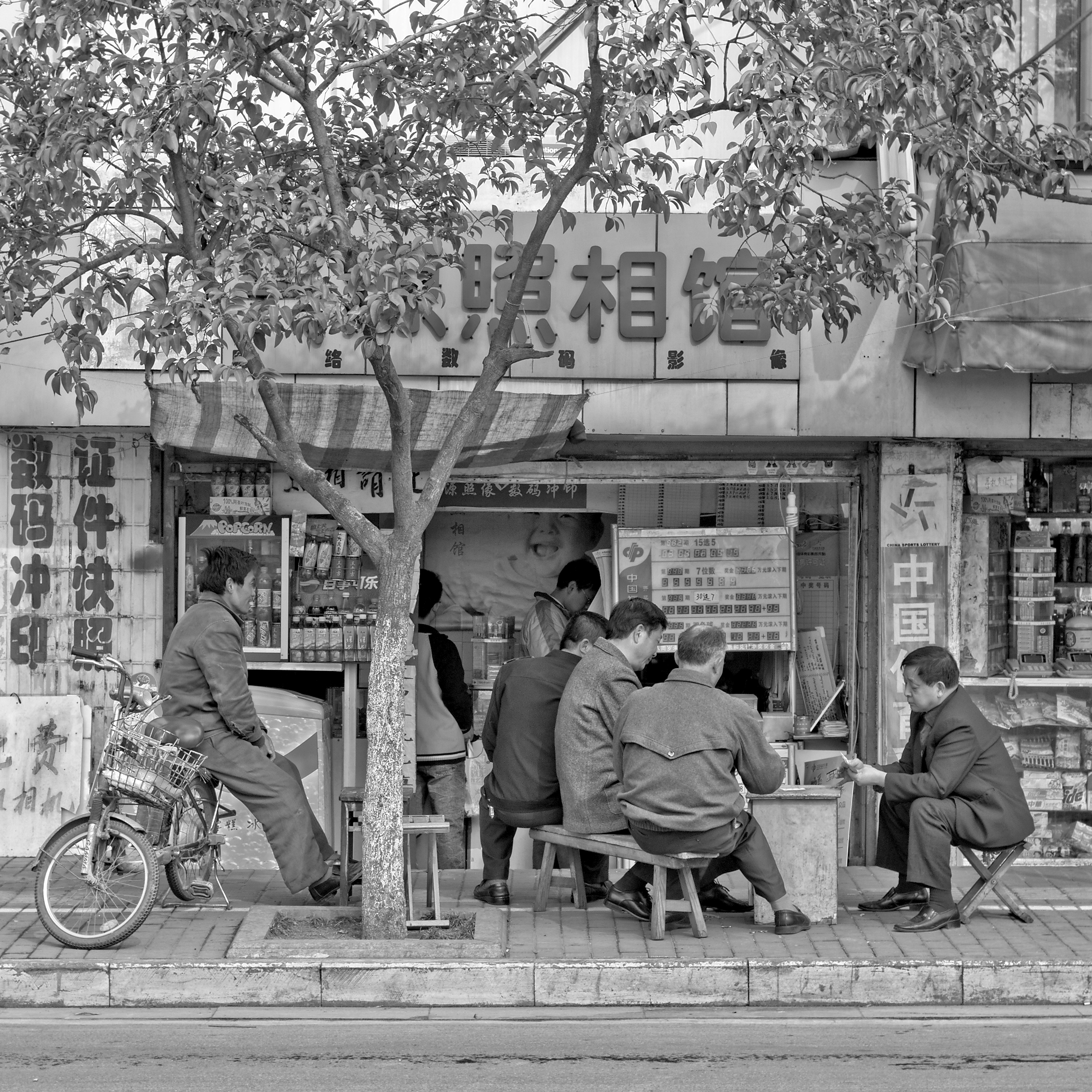|
Zi Pai
''Zi pai'' (; also ''pao fu zi'' or ''pao hu zhi'' [] in different dialects) are Chinese playing cards that are popular mainly in the southern part of Mainland China, especially in Hunan and Sichuan. It is also known as . Description These cards originated from Leshan, Sichuan during the middle of the Qing dynasty and then spread outwards to other parts of southern China. The special deck has two series of cards numbered from one to ten. One series of cards features numbers written in an "ordinary" style (), while the other series of cards has numbers written in a "formal" style (). Every card is quadrupled to bring the total to 80 cards. Numbers 2, 7 and 10 are printed in red, and all others are printed in black. Some decks may have extra cards that act as wild cards. 2-7-10 2-7-10 () is the standard game played with these cards. It is a draw-and-discard type game like Mahjong and Rummy. Usually there are only three players in each game. The winner is the player who reaches 18 p ... [...More Info...] [...Related Items...] OR: [Wikipedia] [Google] [Baidu] |
Deck Of Zi Pai Cards, Fanned Out
Deck may refer to: A level or platform Buildings and structures *Deck (bridge), the roadway surface of a bridge *Deck (building), an outdoor floor attached to a building made of wood or wood-like material *Another name for a storey *The concrete or tile area surrounding a swimming pool *Deck arch bridge, a type of bridge *Observation deck, a platform situated upon a tall architectural structure or natural feature *Orthotropic deck *Roof deck, the framing and sheathing to which roofing material is applied Transportation *Bus deck, referring to the number of passenger levels on a bus *Cockpit, also called a "flight deck" Maritime *Deck (ship), a floor of a ship *Flight deck of an aircraft carrier Audiovisual equipment *Cassette deck, a type of tape machine for playing and recording compact cassettes *Head unit *Phonograph turntable *Tape deck, a sound recording and playback device People *Deck (surname) *Deck McGuire (born 1989), American baseball player Other uses *Deck (cards), ... [...More Info...] [...Related Items...] OR: [Wikipedia] [Google] [Baidu] |
China
China, officially the People's Republic of China (PRC), is a country in East Asia. It is the world's most populous country, with a population exceeding 1.4 billion, slightly ahead of India. China spans the equivalent of five time zones and borders fourteen countries by land, the most of any country in the world, tied with Russia. Covering an area of approximately , it is the world's third largest country by total land area. The country consists of 22 provinces, five autonomous regions, four municipalities, and two Special Administrative Regions (Hong Kong and Macau). The national capital is Beijing, and the most populous city and financial center is Shanghai. Modern Chinese trace their origins to a cradle of civilization in the fertile basin of the Yellow River in the North China Plain. The semi-legendary Xia dynasty in the 21st century BCE and the well-attested Shang and Zhou dynasties developed a bureaucratic political system to serve hereditary monarchies, or dyna ... [...More Info...] [...Related Items...] OR: [Wikipedia] [Google] [Baidu] |
Chinese Playing Cards
Playing cards () were most likely invented in China during the Southern Song dynasty (1127–1279). They were certainly in existence by the Mongol Yuan dynasty (1271-1368).Lo, Andrew. (2000)The Game of Leaves: An Inquiry into the Origin of Chinese Playing Cards Bulletin of the School of Oriental and African Studies, University of London, 63(3), 389–406. Chinese use the word ''pái'' (), meaning "plaque", to refer to both playing cards and tiles.Lo, Andrew (2004) 'China's Passion for Pai: Playing Cards, Dominoes, and Mahjong.' In: Mackenzie, C. and Finkel, I., (eds.), Asian Games: The Art of Contest. New York: Asia Society, pp. 227-229. Many early sources are ambiguous, and do not specifically refer to paper ''pái'' (cards) or bone ''pái'' (tiles). In terms of game play, however, there is no difference; both serve to hide one face from the other players with identical backs. Card games are examples of imperfect information games as opposed to Chess or Go. Many western scholars, ... [...More Info...] [...Related Items...] OR: [Wikipedia] [Google] [Baidu] |
Hunan
Hunan (, ; ) is a landlocked province of the People's Republic of China, part of the South Central China region. Located in the middle reaches of the Yangtze watershed, it borders the province-level divisions of Hubei to the north, Jiangxi to the east, Guangdong and Guangxi to the south, Guizhou to the west and Chongqing to the northwest. Its capital and largest city is Changsha, which also abuts the Xiang River. Hengyang, Zhuzhou, and Yueyang are among its most populous urban cities. With a population of just over 66 million residing in an area of approximately , it is China's 7th most populous province, the fourth most populous among landlocked provinces, the second most populous in South Central China after Guangdong and the most populous province in Central China. It is the largest province in South-Central China and the fourth largest among landlocked provinces and the 10th most extensive province by area. Hunan's nominal GDP was US$ 724 billion (CNY 4.6 trillion) a ... [...More Info...] [...Related Items...] OR: [Wikipedia] [Google] [Baidu] |
Sichuan
Sichuan (; zh, c=, labels=no, ; zh, p=Sìchuān; alternatively romanized as Szechuan or Szechwan; formerly also referred to as "West China" or "Western China" by Protestant missions) is a province in Southwest China occupying most of the Sichuan Basin and the easternmost part of the Tibetan Plateau between the Jinsha River on the west, the Daba Mountains in the north and the Yungui Plateau to the south. Sichuan's capital city is Chengdu. The population of Sichuan stands at 83 million. Sichuan neighbors Qinghai to the northwest, Gansu to the north, Shaanxi to the northeast, Chongqing to the east, Guizhou to the southeast, Yunnan to the south, and the Tibet Autonomous Region to the west. In antiquity, Sichuan was the home of the ancient states of Ba and Shu. Their conquest by Qin strengthened it and paved the way for Qin Shi Huang's unification of China under the Qin dynasty. During the Three Kingdoms era, Liu Bei's state of Shu was based in Sichuan. The ... [...More Info...] [...Related Items...] OR: [Wikipedia] [Google] [Baidu] |
Leshan
Leshan, formerly known as Jiading or Jiazhou, is a prefecture-level city located at the confluence of the Dadu and Min rivers in Sichuan Province, China. Leshan is located on the southwestern fringe of the Sichuan Basin in southern Sichuan, about from Chengdu.Leshan is an important industrial city in Sichuan, a regional center city in the south of Chengdu Economic Zone, an important hub city, an important transportation node and a port city in Chengdu-Chongqing.As of the 2020 census, its population was 3,160,168, of whom 1,236,188 lived in the built-up (''or metro'') area made of Shizhong, Wutongqiao, Shawan and Jinkouhe districts. Leshan is a famous historical and cultural city with the reputation of "Begonia Fragrance Country". It is the first open-door city, model green city, excellent tourist city, national garden city and national health city. Leshan has three world-class heritage sites - world natural and cultural heritage Emei Mountain and Leshan Buddha, world irrigation ... [...More Info...] [...Related Items...] OR: [Wikipedia] [Google] [Baidu] |
Qing Dynasty
The Qing dynasty ( ), officially the Great Qing,, was a Manchu-led imperial dynasty of China and the last orthodox dynasty in Chinese history. It emerged from the Later Jin dynasty founded by the Jianzhou Jurchens, a Tungusic-speaking ethnic group who unified other Jurchen tribes to form a new "Manchu" ethnic identity. The dynasty was officially proclaimed in 1636 in Manchuria (modern-day Northeast China and Outer Manchuria). It seized control of Beijing in 1644, then later expanded its rule over the whole of China proper and Taiwan, and finally expanded into Inner Asia. The dynasty lasted until 1912 when it was overthrown in the Xinhai Revolution. In orthodox Chinese historiography, the Qing dynasty was preceded by the Ming dynasty and succeeded by the Republic of China. The multiethnic Qing dynasty lasted for almost three centuries and assembled the territorial base for modern China. It was the largest imperial dynasty in the history of China and in 1790 the f ... [...More Info...] [...Related Items...] OR: [Wikipedia] [Google] [Baidu] |
Wild Card (card Games)
A wild card in card games is one that may be used to represent any other playing card, sometimes with certain restrictions. These may be jokers, for example in Rummy games, or ordinary ranked and suited cards may be designated as wild cards such as the and in Classic Brag or the "deuces wild" in Poker.''The Language of Cards: A glossary of card-playing terms'' by David Parlett at www.parlettgames.uk. Retrieved 1 Jun 2018. A card that is not wild may be referred to as a . Jokers, however, may also have other uses, such as being a permanent top trump. Use In most cases, the wild card or cards must be agreed upon by all players before t ...[...More Info...] [...Related Items...] OR: [Wikipedia] [Google] [Baidu] |
Mahjong
Mahjong or mah-jongg (English pronunciation: ) is a tile-based game that was developed in the 19th century in China and has spread throughout the world since the early 20th century. It is commonly played by four players (with some three-player variations found in parts of China, Japan, South Korea and Southeast Asia). The game and its regional variants are widely played throughout East Asia, East and Southeast Asia and have also become popular in Western countries. The game has also been adapted into a widespread online entertainment. Similar to the Western card game rummy, Mahjong is a game of skill, strategy, and luck. To distinguish it from mahjong solitaire, it is sometimes referred to as mahjong rummy. The game is played with a set of 144 Mahjong tiles, tiles based on Chinese characters and Chinese culture, symbols, although many regional variations may omit some tiles or add unique ones. In most variations, each player begins by receiving 13 tiles. In turn, players draw ... [...More Info...] [...Related Items...] OR: [Wikipedia] [Google] [Baidu] |
Rummy
Rummy is a group of matching-card games notable for similar gameplay based on matching cards of the same rank or sequence and same suit. The basic goal in any form of rummy is to build '' melds'' which can be either sets (three or four of a kind of the same rank) or runs (three or more sequential cards of the same suit) and either be first to go out or to amass more points than the opposition. Origin There are two common theories about the origin of Rummy, attributing its origins in either Mexico or China in the nineteenth century. The first is that it originated in Mexico around the 1890s in a game described as Conquian in R.F. Foster's book ''Foster's Complete Hoyle'', which was played with a 40 card Spanish deck and had melding mechanics. The second is that Rummy originated in Asia, and that Rummy was the result of a Mahjongg variant named Kun P'ai that was Westernized as Khanhoo by W.H. Wilkinson in 1891. Games scholar David Parlett combines these two theories, and p ... [...More Info...] [...Related Items...] OR: [Wikipedia] [Google] [Baidu] |
Sheng Ji
''Sheng ji'' is a family of point-based, trick-taking card games played in China and in Chinese immigrant communities. They have a dynamic trump, i.e., which cards are trump changes every round. As these games are played over a wide area with no standardization, rules vary widely from region to region. The game can be played with multiple decks of cards. With one deck, it may be called ''dǎ bǎi fēn'' (, 'competing for a hundred points') or ''sìshí fēn'' (, 'forty points'); with two decks, as is most commonly played, it may be called ''bāshí fēn'' (, 'eighty points'), ''tuō lā jī'' (, 'tractor'), ''shuāng kōu'' (, 'double digging out'), or ''shuāng shēng'' (, 'double upgrade'); another variant is called ''zhǎo péngyǒu'' (, 'Finding Friends'), which has five or more players and two or more decks. The article below mainly describes the ''bashi fen'' variant, with players playing with two decks and in fixed partnerships. Players and objective The game is played ... [...More Info...] [...Related Items...] OR: [Wikipedia] [Google] [Baidu] |






